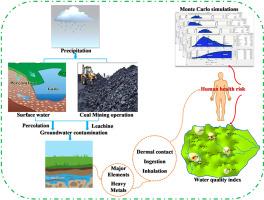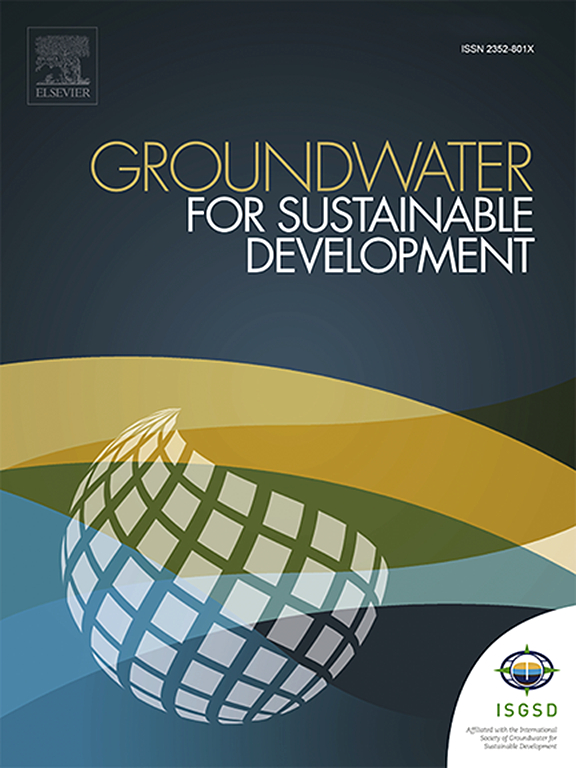在尼日利亚 Maiganga 流域使用蒙特卡洛方法结合修改后的水质指数评估有毒金属健康风险
IF 4.9
Q2 ENGINEERING, ENVIRONMENTAL
引用次数: 0
摘要
地质活动和人为活动引发了热带稀树草原流域致癌和非致癌污染物的积累。本研究利用人类健康风险评估模型,通过蒙特卡洛方法确定非致癌和致癌毒素对尼日利亚 Maiganga 流域居民的影响。采用修正水质指数(MWQI)来评估与饮用水水质相关的健康风险。总体水质指数表明饮用水是安全的,因此,81% 的地下水适合饮用,7.1% 的地下水被认为是劣质水,不能安全饮用。NO3、F、Cr、Pb 和 Ni 是 Maiganga 地下水中普遍存在的主要致癌和非致癌污染物。露天井水的非致癌风险范围为:儿童 0.6402 至 23.1994,女性 0.2673 至 9.4625,男性 0.2101 至 9.4569。而在井孔中,儿童的这一数值从 1.2151 到 31.4620 不等,女性和男性的这一数值分别从 0.3279 到 12.4679 和 0.2576 到 12.4228 不等。对露天水井和井眼进行的蒙特卡洛最佳情况致癌风险评估证实,来自露天水井的水样诱发癌症的风险相对较高。因此,Maiganga 地下水中主要的非致癌和致癌污染物是 NO3、F、Cr、Pb 和 Ni。儿童极易受到致癌和非致癌污染物的影响,其次是女性和男性。要为农村社区提供清洁安全的饮用水,就必须对有害污染物进行管制。本文章由计算机程序翻译,如有差异,请以英文原文为准。

Toxic metals health risks assessment using the Monte-Carlo approach coupled with modified water quality index evaluation in Maiganga watersheds, Nigeria
Geogenic and anthropogenic activities trigger the accumulation of carcinogenic and non-carcinogenic contaminants in the tropical savanna watershed. This study utilized the human health risk assessment model to identify the effects of non-carcinogenic and carcinogenic toxins in the inhabitants of the Maiganga watershed Nigeria through the Monte-Carlo approach. The modified water quality index (MWQI) was employed to assess the health risks linked to drinking water quality. The overall water quality index suggests that the water is safe to drink, Thus, 81 % of the groundwater is suitable for drinking, while 7.1 % is considered poor and unsafe for drinking. NO3, F, Cr, Pb, and Ni are the key carcinogenic and non-carcinogenic contaminants prevalent in Maiganga groundwater. The non-carcinogenic risk derived from open wells ranges from 0.6402 to 23.1994 in children, 0.2673–9.4625 for females, and 0.2101–9.4569 for males. While in boreholes, it varies from 1.2151 to 31.4620 in children, whereas for females and males, it ranges from 0.3279 to 12.4679 and 0.2576–12.4228, respectively. The Monte-Carlo carcinogenic risk of the best-case scenario evaluated for the open well and borehole confirms that water samples sourced from open wells pose a relatively higher risk of cancer inducement. Therefore, the critical non-carcinogenic and carcinogenic contaminants dominating the Maiganga groundwater are NO3, F, Cr, Pb, and Ni. Children are highly susceptible to carcinogenic and non-carcinogenic exposure, followed by females and males. Regulating hazardous pollutants is mandatory for providing clean and safe drinking water to rural communities.
求助全文
通过发布文献求助,成功后即可免费获取论文全文。
去求助
来源期刊

Groundwater for Sustainable Development
Social Sciences-Geography, Planning and Development
CiteScore
11.50
自引率
10.20%
发文量
152
期刊介绍:
Groundwater for Sustainable Development is directed to different stakeholders and professionals, including government and non-governmental organizations, international funding agencies, universities, public water institutions, public health and other public/private sector professionals, and other relevant institutions. It is aimed at professionals, academics and students in the fields of disciplines such as: groundwater and its connection to surface hydrology and environment, soil sciences, engineering, ecology, microbiology, atmospheric sciences, analytical chemistry, hydro-engineering, water technology, environmental ethics, economics, public health, policy, as well as social sciences, legal disciplines, or any other area connected with water issues. The objectives of this journal are to facilitate: • The improvement of effective and sustainable management of water resources across the globe. • The improvement of human access to groundwater resources in adequate quantity and good quality. • The meeting of the increasing demand for drinking and irrigation water needed for food security to contribute to a social and economically sound human development. • The creation of a global inter- and multidisciplinary platform and forum to improve our understanding of groundwater resources and to advocate their effective and sustainable management and protection against contamination. • Interdisciplinary information exchange and to stimulate scientific research in the fields of groundwater related sciences and social and health sciences required to achieve the United Nations Millennium Development Goals for sustainable development.
 求助内容:
求助内容: 应助结果提醒方式:
应助结果提醒方式:


